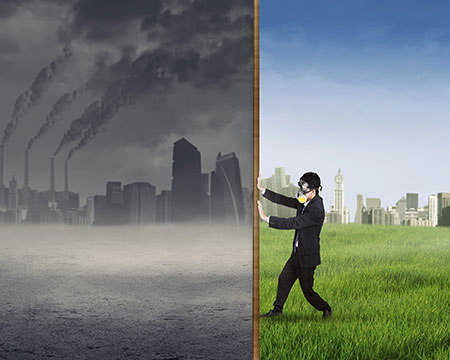
Breathing Clean Air: Institutional Frameworks

Deterioration of air quality has become a critical issue in many developing economies across the world. Figure 1 shows the top 15 cities with the highest levels of PM2.5 globally (WHODatabase of 2016).Air pollution has substantial impacts on human health, agriculture, and the economy. Globally, 6.5 million mortalities have been attributed to ambient air pollution in 2016, which includes 1.7 million children below 5 years of age. Global relative yield losses are estimated to be 7%–12% for wheat and 3%–4% for rice crops1(Dingenenet al. 2009).

Several cities in the developed world also suffered from deterioration of air quality in the past in the course of their growth. Cities, such asSan Francisco, Los Angeles, and London have grappled with air pollution levels that were among the highest recorded in the world during the 1940–1960s, similar to the situation in several developing countries today. The experience of cities in the USA and Europe shows that air pollution is not an intractable issue. Through appropriate regulatory and policy interventions, backed by effective institutional mechanisms, many cities have been successful in bringing down pollution. California, for instance, was able to reduce the levels of all air pollutants by 75%–90%(Figure 2). Similarly, reduction measures taken in Europe (EU27 countries) since 1970, led to a decrease of 71% NOx and 69% PM2.5 emissions2(EEA, 2016).
Mexico City, which was among the most polluted cities globally in the early 1990s, has managed to reduce pollution levels through a Comprehensive Program Against Air Pollution (ProAire) that included the creation of Metropolitan Environmental Commission (MEC) to coordinate among the federal and local governments of Mexico City and the State of Mexico. Mexico City won the 2013 C40 & Siemens Climate Leadership Awards’ Air Quality category for the ProAire program.
China started addressing the challenge of rising air pollution using amulti-sectorial approach to effectively handle the issues around diverse sources and controlling agenciesat the province/sub-national level. Stricter norms have been introduced for power plants and transport sector which has led to reduction in emissions. For instance, Hebei province,in the vicinity of Beijing,has implemented the Hebei Pollution Prevention and Control Implementation Action Plan (HAP) with financial assistance from the World Bank. The coordination of the HAP is carried out by the High-level Provincial Working Group.

High-level Provincial Working Group of the Hebei Pollution Prevention and Control Implementation Action Plan
Though, there is more than adequate evidence now that air pollution places a significant burden on human health and economic productivity, its yet to get the high priority in public policy in many parts of the world. It needs to be recognized that air pollution is a complex issue as it involves multiple, interacting, and inter-jurisdictional pollution sources. Consequently, many stakeholders have to come together and agree on the way forward. To Illustrate, Figure 4shows the number of central government agencies that have a bearing on air pollution in India.A similar corresponding structure of departments also exists at the state government level.

Key agencies that have a bearing on air pollution in India
There is much that countries at similar level of development can learn from each other’s experiences on a multitude of regulatory, policy, and institutional aspects. These include the following:
- Coordination on policy design, resource mobilization, capacity development, and implementation
- Institutional coordination among multiple agencies as well as across tiers of government in federal systems
- Evolving consensus among all stakeholders
- Ease of implementation
- Comparative analysis of mitigation options for their cost-effectiveness
- Pros and cons of different regulatory and market-based instruments
In order to address these issues enumerated earlier, a plenary session on ‘Breathing Clean Air: Institutional Framework’ is being organized in the World Sustainable Development Summit, during 15–17 February 2018. The event will call upon the Ministers of Environment from different parts of the world to discuss and understand the institutional frameworks used across the world for control of air pollution.The discussion, as part of the session, will focus on the strategies and institutional frameworks required for air pollution control and prevention and will provide an opportunity to understand the views and perspectives of the policy makers in different countries, including Japan, India, Mexico, and China. The session aims to address the gaps in the institutional framework and management instruments to control the level of air pollution across the world.
EEA [European Environment Agency] Air Quality in Europe. No 28/2016. www.eea.europea.eu. ISSN 1977-8499